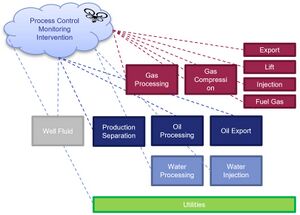Difference between revisions of "Remote Operated Processing Platform"
| Line 30: | Line 30: | ||
The table below show a list of FOMs by which a remote operated processing platform can be assessed. The first two highlight the driver to maintain capability for maximum design throughput of a facility with minimum number of personnel onsire, with a target of zero. Water depth is a FOM that we are continuing to develop, with a thought that the theoretical limit to a remote operated facility will likely be limit in technology for location, which translates to water depth of the facility. Unit cost (CAPEX expenditure) and operating costs are directly correlated with the reduction of personnel onsite full time operating and maintaning a facility. Lastly, Total Recordable Incident rate is an emergent FOM derived from reduction in personnel exposure will result in reduction in incident rate. | The table below show a list of FOMs by which a remote operated processing platform can be assessed. The first two highlight the driver to maintain capability for maximum design throughput of a facility with minimum number of personnel onsire, with a target of zero. Water depth is a FOM that we are continuing to develop, with a thought that the theoretical limit to a remote operated facility will likely be limit in technology for location, which translates to water depth of the facility. Unit cost (CAPEX expenditure) and operating costs are directly correlated with the reduction of personnel onsite full time operating and maintaning a facility. Lastly, Total Recordable Incident rate is an emergent FOM derived from reduction in personnel exposure will result in reduction in incident rate. | ||
[[File:Foms.jpg|largepx|thumb]] | |||
***NEED governing equation | |||
==Alignment with Company Strategic Drivers== | ==Alignment with Company Strategic Drivers== | ||
Revision as of 18:38, 7 October 2019
Technology Roadmap Sections and Deliverables
On an offshore oil and gas platform, operators are physically located on the facility to provide local intervention with a goal of ensuring safe, reliable processing capabilities. Introduction of a remote operated platform removes operations and maintenance personnel from being physically located on the platform to a central operating location where the focus is on real-time monitoring and intervention is achieved.
Roadmap Overview
The working principle and architecture of a remote operated oil and gas processing platform is depicted in the below.
details
Design Structure Matrix (DSM) Allocation
We can extract from the DSM above that the remote operated processing platform is composed of and dependent on a series of decisions and technologies. These decisions and subsequent technologies include facility location, communication and control method, process design, monitoring and intervention.
Roadmap Model using OPM
We provide an Object-Process-Diagram (OPD) of the in the figure below. This diagram captures the main object of the roadmap (oil platform), its various processes required for transferring of information to control the facility remotely, as well as the Figures of Merit and main processes.
An Object-Process-Language (OPL) description of the roadmap scope is auto-generated via Opcloud and provided below. This is simply an export of the OPD in a formal natural language.
Figures of Merit
The table below show a list of FOMs by which a remote operated processing platform can be assessed. The first two highlight the driver to maintain capability for maximum design throughput of a facility with minimum number of personnel onsire, with a target of zero. Water depth is a FOM that we are continuing to develop, with a thought that the theoretical limit to a remote operated facility will likely be limit in technology for location, which translates to water depth of the facility. Unit cost (CAPEX expenditure) and operating costs are directly correlated with the reduction of personnel onsite full time operating and maintaning a facility. Lastly, Total Recordable Incident rate is an emergent FOM derived from reduction in personnel exposure will result in reduction in incident rate.
- NEED governing equation




